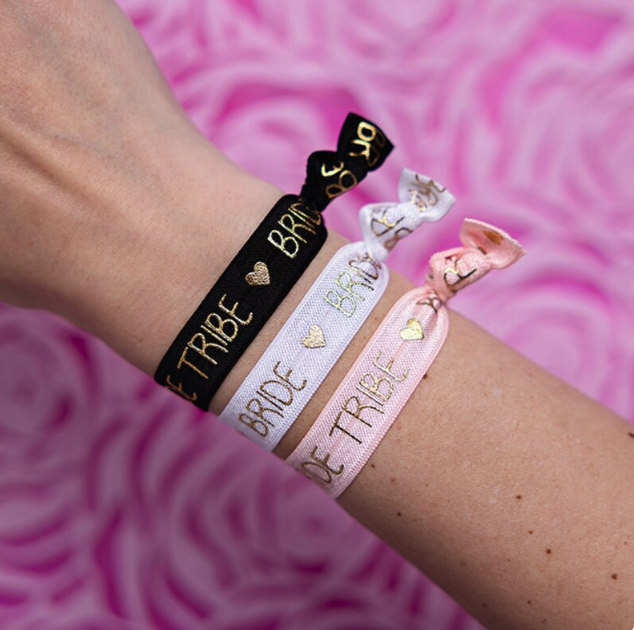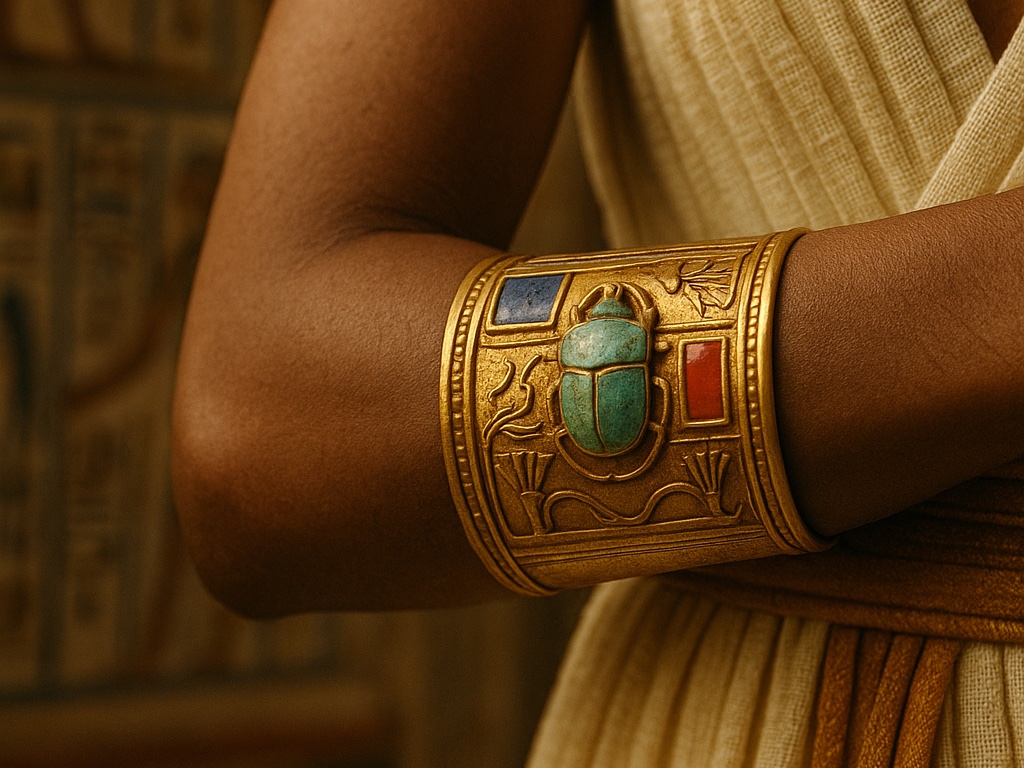- Free shipping on every order
- Same day dispatch
- Price beat guarantee
Menu
Blog The History of Wristbands

Wristbands are a simple yet highly effective product that are most commonly used today as a means of identification or expression of ideas, and this tradition has deep historical roots.
Many of us take wristbands for granted; however, it is important to understand their rich history to truly appreciate and understand the many ways that they can be used.
This article will trace the history of wristbands back to the ancient Egyptians, before exploring their use in a wide array of cultural and practical uses that span centuries. This helps with the understanding of how wristbands are used today in many different settings, ranging from sporting events to music festivals.
Finally, we will look to the future and examine the exciting ideas and technological advances that are likely to transform the wristband sector and help it to evolve further to meet people’s changing needs.
Let’s get into it!
Many people do not realise that the use of wristbands has ancient origins, dating back to the BC era. Initially, the Egyptians made use of wristbands, often for spiritual or ceremonial purposes.
These early wristbands were typically made from fine materials, such as gold, faience, and gemstones, and incorporated rich symbolism into the designs.
Ancient Greek and Roman societies further developed the use of wristbands for a wide range of purposes. They were often used as military insignia to express rank or skill, or simply as decorative wear by wealthy members of society.
They introduced new designs and materials, such as leather or cotton, to make the wristbands.

Wristband materials have changed throughout history, and have evolved as the need and use of wristbands have changed.
Historically, wristbands were primarily made from leather due to its durability and availability. Leather wristbands were used by warriors and soldiers on the battlefield to denote rank and allegiance, and thus durability of the leather was highly valued.
Metal wristbands were also used during this time by the Egyptians and Romans. These wristbands were made from precious metals such as bronze or gold, and were often seen as a symbol of rank. At the same time, they were often used for spiritual reasons and engraved with symbolic designs. Fabric wristbands also made an appearance during this era, most commonly in Asia, and were used in religious and ceremonial contexts.
As time passed, wristbands evolved from being primarily used for religious and symbolic reasons to more functional and aesthetic uses. As science progressed and new materials developed, the use of wristbands significantly changed. In the late 20th century, plastic wristbands became a popular accessory amongst teens.
In the early 2000s, plastic and fabric wristbands continued to be a popular accessory. As manufacturing processes improved, they also started to serve a more practical purpose. New durable fabrics and plastics allowed wristbands to become an excellent resource for concerts and music festivals as a way to identify attendees.
Today, wristbands are primarily made from nylon or plastic and serve a wide range of functional and aesthetic purposes.
Wristbands have served a much wider purpose than merely being a functional resource or an aesthetic choice. Many different cultures have used wristbands as a symbol of identity, protection, and status across the world.
In Native American culture, for example, leather and beaded wristbands were often used as an expression of tribal history. Additionally, in certain traditions, it is common practice to be given a wristband after experiencing a major life event, such as puberty or marriage, and these wristbands signify cultural belonging.
Alternatively, some cultures use wristbands as talismans for protection or to show spiritual belief. In some Theravada Buddhist traditions, monks create and bless wristbands made from silk or fabric, called sai sin. These wristbands are thought to ward off evil and protect the wearer from harm. It is also a common practice in Hinduism to wear raksha sutra or kalava, a red thread bracelet given to men and women as a part of a spiritual ceremony and sign of faith.
Wristbands have also been used by many ancient cultures as indicators of wealth and power. Powerful members of ancient Egyptian society, such as royalty and priests, often wore gold wristbands adorned with precious gemstones to signify their status.

Wristbands have played a fundamental role in many different historical events, as a means of identification or as a symbolic artefact.
Although dog tags were the primary form of identification during the World Wars, bracelets and wristbands have also been used for military identification in various contexts. Soldiers on each side would wear identifier bracelets as a part of their uniform to help men from their side, and the enemy, know which army they served. In the chaos of the battlefield, this was a fundamental way for armies to track and identify their men.
Additionally, it allowed soldiers and civilians to distinguish one another to ensure as few people as possible were caught in the crossfire as possible.
In the 1970s and 1980s, wristbands started to take on a more practical use within the festival sector. For one, wristbands were a great way for attendees to identify themselves as ticket holders, and they allowed them to come and go from a multiple-day festival. This was commonly seen at large music festivals such as Glastonbury in the United Kingdom.
However, wristbands have also become a sentimental item for many festival goers, who keep them after the event has finished as a souvenir.
Wristbands have also served a ritualistic purpose throughout history and are deeply ingrained in many religious and cultural traditions.
As mentioned earlier, raksha sutra or kalava serve a key ritualistic purpose, and are given to both men and women during Hindu ceremonies such as worship, or certain religious festivals like Diwali. Certain tribal communities, such as the Maasai of East Africa, also use beaded wristbands crafted in specific colours and patterns to denote age, marital status, and social identity.
Wristbands are now a product of the times and have evolved alongside technology into a product that is highly functional across a range of purposes.
Technological advancements in the last 30 years have created some incredible devices, and many of these devices have been combined with the functional power of wristbands to create highly practical products. For example, many modern wristbands now also feature a smart device, such as a watch or fitness tracker. The wristband allows for easy wearing and use of the device, and forms a core part of its design.
Social media and celebrity culture have also had a major impact on the evolution of wristbands, as they are now often a way to make a statement. Many celebrities release merchandise lines that include a wristband of some sort, so that the wearer can subtly show that they are a fan with their everyday outfit. Additionally, the supporters of many of the social causes that have erupted over the internet also wear wristbands that contain messages that align with the cause to show their support.
The modern sporting world also makes great use of wristbands. Athletes often wear wristbands when competing as a form of sweat absorption or protection. This is commonly seen in sports such as tennis or basketball, where players often wear wristbands to protect their hands from sweat during the game.
Coaches and support staff of particular teams are also often given wristbands at big events to ensure that they have access to the right areas to properly support their players.
Wristbands are also used as a means of team identification at big meets and races. Marathon runners are often administered wristbands before they race to ensure they are identified and tracked properly while competing.
Wristbands also carry significant symbolic purposes, helping individuals to express their ideas to those around them.
They are commonly utilised by charities as a way to help raise funds and spread their message. Often, donors to a specific cause are given a wristband in turn, which they can then wear to show their support for the charity and increase awareness so that impact is made within their community.
Charity wristbands are also a sign of unity and solidarity. Wearers of the same wristband can easily recognise one another and feel a sense of purpose and belonging, which helps to further inspire group activity and a collective purpose.
Finally, many individuals choose to wear wristbands as a way to express their style, as they incorporate them into their everyday outfits. This allows them to convey their identity and values with ease, while also staying in touch with their style preferences.
The wristband industry is much larger than many may realise, and it is only getting bigger. Increased demand for wristbands, as well as constant innovation in designs and materials, has allowed the industry to boom and have a considerable economic impact.
However, some concerns have been raised about the environmental impact this growing industry is having. Some are doubtful about the production process of wristbands and believe that the process may be creating excessive waste.
As a result, there has been a significant push for more sustainable and transparent manufacturing processes within the wristband industry.
Additionally, some highlight the ethical considerations around the manufacturing process of wristbands. There is some concern that unethical labour practices, including underpayment or harsh conditions for workers, occur within the wristband industry.
This stresses the need for fair-trade and sustainable policies to ensure that all wristbands are responsibly produced.
At The Wristband Co., we’re committed to ethical sourcing and sustainable practices to ensure our products are responsibly made.
One thing is for sure – the wristband industry isn’t slowing down, and as a result, we can expect big things in terms of innovation in this sector.
The recent rise of biotechnology applications indicates that wristbands with smartwatches and fitness trackers are only going to get better. This likely results in better health monitoring, and users being more easily able to track their biometric data to receive, understand and improve their health.
Additionally, we may be seeing a widespread improvement in wristband quality across the industry, thanks to the introduction of new materials. Nano-materials and smart plastics have proven to be exceptionally durable and may change the game when it comes to wristband longevity and use.
Furthermore, as technological integration with wristbands becomes more common, we will likely see some of the more advanced technological inventions also integrated. This means that wristbands may soon start to include virtual and augmented reality tools to give users a fully personalised experience. If this happens, this could really transform the wristband industry into something we could have never imagined.
Wristbands have a rich history, spanning centuries, that has led to the practical products that we all know and love today.
From use by ancient Egyptians and Romans to their significant role in a diverse array of cultures, wristbands carry a lot of meaning and significance for many people across the world.
Today, wristbands are used across a wide variety of sectors – from sports to music festivals, social causes, and even corporate events. They are a fantastic way to show support or identify yourself as a part of a particular group, no matter where you go. It is clear that the use of wristbands has evolved throughout history, and they will likely continue to do so as new contemporary trends emerge.
Looking ahead, we can expect the booming wristband industry to only grow more, thanks to the continuous stream of technological advances the world is seeing.
If you need wristbands for your next social event, a certain cause, or even a corporate function, we at The Wristband Co. can give you a hand. Feel free to give us a call on 08 8363 4850 or email us at [email protected] to speak to one of our friendly team members and have them help you to create wristbands that suit you and your needs.


Join our mailing list to receive product information, endless inspiration and 10% off your next order!


Monday – Friday 8:30 AM-8:30 PM
Saturday 10:00 AM-5:00 PM
Sunday CLOSED
38 Little Rundle Street Kent Town SA 5067
08 8363 4850
ABN: 62 239 772 879
The Wristband Co. is located on the traditional lands for the Kaurna people, and we respect their spiritual relationship with their Country. We also acknowledge the Kaurna people as the custodians of the Adelaide region and that their cultural and heritage beliefs are still as important to the living Kaurna people today.
Payments Accepted